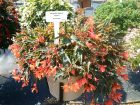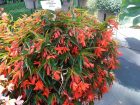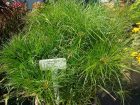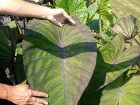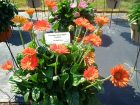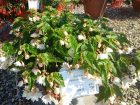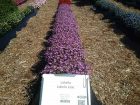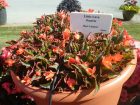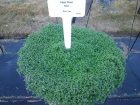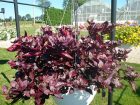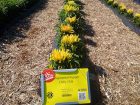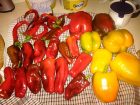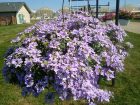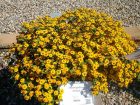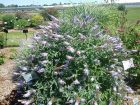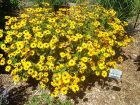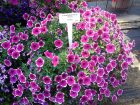
Features
New Varieties
Viewing some summer garden trials standouts
August 24, 2016 By Brad McMillan JVK
Aug. 24, 2016 – Veteran horticulturist Brad McMillan of JVK spent a few days this summer checking the trial gardens at JVK in St. Catharines and the Raker Trial Gardens in Michigan. Here’s a few of the varieties that caught his eye!
I’m a big fan of Sweet Portugal, Sweet Yellow and Red, and one of my favourites, Sweet Heat, for my mixed pickled peppers. Spicy-sweet … yummm! Grown in my greenhouse this summer, despite the hot summer.
Here’s a strong, relatively new variety from the breeders at Kientzler to stimulate sales of nemesia. Babycake Little Orange consistently has excellent flower cover, and a good habit, as you can see from this photo. It has an explosion of rich orange and cherry-red flowers growing from the planter, trailing down towards the ground, and it shows no sign of slowing down! I can envision this mixed with something white, or dark-blue for contrast, making for a nice retail presentation.
With all the lawns, ditches, and fields across Ontario looking completely burnt, one has to appreciate a fresh, crisp looking white petunia such as Syngenta’s Sanguna Series White, pictured here. Loads of fresh, clean, white flowers and nice dark-green foliage with a good habit. No wonder Sanguna has been a staple within most growers petunia offerings for some years now. Syngenta has continued to improve the series through breeding, and in my opinion, it shows. This specimen puts one in mind of late spring, not mid-summer.
Talk about creeping, prostrate growth! PanAm Seeds’ Mini Mint (non-edible) appears to be the epitome of both those characteristics. It has moist, green, tiny foliage with a super-dense, creeping habit and tiny flowers. See it rolling over the edge of the container in the photo? That’s very representative of other examples I’ve seen of this great variety of PanAm. If only my lawn was a green and dense … and minty.
Little, but cute. Hort Couture’s Little Lava begonia originates from Boliviensis-type plants, but has been turned into a dwarf-form through breeding. Growing very densely in this container, and quite prostrate as you can see, I can imagine this planted alongside sea-shells, rocks, small fairy statues, gnomes (maybe not gnomes, as they can be capricious at times), or perhaps succulents, or HC’s line of dwarf coleus, the Sea Monkey Series. This specimen of Little Lava has held up very well this summer, and has held its dwarf-habit.
What a pretty, cheerful, coreopsis we see here, with PanAm Seed’s Sun Kiss Coreopsis. Lots of flowers with beautiful colour and pattern, sturdy, upright stems, loads of new flower-buds coming on, and green foliage, despite the intense sun and humidity this year. Coreopsis is known for its low-maintenance requirements, long bloom-time, and range of colour. If offered in the right format, these qualities are exactly what consumers are looking for, which should make for good retail sales.
Cyperus, a member of the sedge family of plants, has really caught on since Proven Winners first released its original, King Tut, back several years ago. Then, came Baby Tut, the dwarf version. Now, we have another new category – the mid-size cyperus. New Prince Tut from Proven Winners will surely please those growers and consumers wanting something, well, right in between the size of The King and The Baby. Overall, to me, Prince Tut has a looser, airier look to the foliage, and will work well in the landscape and in large containers where King Tut would be just way too tall. I think this one will be a hit for the folks at Proven Winners.
Danziger’s Amore Series of petunias all feature prominent, heart-shaped features in the flower pattern. This particular one, called Queen of Hearts, put on a real show this summer, and is one of the favourites of those looking after the trial containers and beds. It certainly has a great shape overall, and has beautiful, vibrant colour, and those little hearts on the flowers – could we make this petunia series work as a Valentine’s Day crop at retail? In northern latitudes, perhaps Amore is more practical as a plant for Mother’s Day.
Anigozanthus needs heat and sun. This summer, of course, has been perfect conditions for this plant to shine. Growers like anigozanthus for its unique appearance and flowers, and there’s nothing else quite like it – a common trait for things native to Australia. If you have customers for summer, heat-loving plants, this Anigozanthus Mix from Greenfuse Botanicals, grown by Pell Greenhouses of Michigan, would be a good choice. It’s not for May or early June sales, but is something to offer at retail further into the summer. I could easily see this mixed with one of the newer, dwarf, white euphorbias to help make the yellow and pink colours of the anigozanthus really pop.
Here’s another plant from the DecoStyle Tropical Collection from Tellier. This beautiful, H-U-U-U-G-E colocasia, Blue Hawaii, has gorgeous, contrasting veining in the leaves. All the colocasia and alocasia from Decostyle nearly doubled in height and girth over the space of a month, with this summer’s heat and humidity. Some growers unfamiliar with tropicals still confuse the two – remember, alocasia leaves generally point up – think “alto ,” as in “high” or “up.” Colocasia leaves generally point downward.
Consumers still love their trailing, spreading petunias, especially in baskets, and Cascadia Rim Cherry petunia from Danziger is an example of why the love still exists. Striking, vivid colour and pattern, great trailing habit, great summer performance – what more could you ask for? All the Cascadias are excellent, but Rim Cherry caught my eye this summer in many different trial gardens.
Here’s an example of DecoStyle’s beautiful, heat-loving Macho Nephrolepis. A terrifically sturdy plant, with beautiful, thick, glossy, green foliage, Macho has thrived in the outdoors this summer in southern Ontario. DecoStyle is a collection of tropicals from Quebec grower, Tellier.
Consumers are still not entirely used to seeing gerbera in garden centres, but they do recognize and love them as a cut flower. The Garvinea Series, born of tissue-culture propagation and breeding by Florist Gerbera, is a terrific plant, profuse with blooms, and demonstrates greatly improved container and garden performance compared with older types of gerbs. This beautiful specimen of Garvinea Sweet Glow came from Ontario grower Orchard Park.
There’s more to Beekenkamp that just begonias, but still one has to appreciate Waterfall Encanto Orange begonia for its shape, flower cover, and brilliant orange colour. This basket has held up amazingly well, don’t you think?
The Beauvillia Series from Beekenkamp is another great Boliviensis-type begonia available to growers. These types of begonias started out several years ago with reds and oranges, but the colour palette is continually improving. Beauvillia Salmon still looks excellent in its basket, covered in pretty, salmon-orange flowers, with nice deep-green foliage and a decent shape.
The Betty Series blue bacopa sure looks good after this hot summer. One wouldn’t normally say “looks good” and “hot summer” about bacopa in the same sentence. You can’t argue with the results of trial after trial, though. Greenfuse really has a good thing going with its bacopa breeding program. Hats off to Steve Jones and the breeders at Greenfuse Botanicals!
Just look at all the sturdy, upright flower spikes on this specimen! There are a few new, annual salvias on the market these days from a number of Breeders. Kientzler’s Candle Series is a good one, to be sure. This Candle White has really held up well over this blistering, hot summer, showing no signs of slowing down.
Vermillion Red Begonia, from the breeders at Beekenkamp, stunned many visitors to Raker’s gardens with its coverage of dark red blooms, hence the number of “favourite” flags seen in the photo. This basket was out in full, scorching sun, along with the other sun-loving tuberous begonias from Beekenkamp.
This brand new introduction of alternanthera from PanAm Seed has been recently named Purple Prince, and was considered an experimental variety until not long ago. The beautiful, dark colour and vigorous habit have impressed many, and have proven this plant’s worth.
Introduced last year by Sakata, Dragon’s Breath celosia has gorgeous, rich, dark-coloured foliage, as seen in this example from Raker’s gardens. The plants in this row were grown under a natural day program, and are just a shade lighter than plants started with shortened days, which can be seen just to the left in the photo. Short-day production will also substantially increase production of flowers. Beautiful, regardless.
There’s a beautiful, Zone 6 perennial lagerstroemia, also known as Crepe Myrtle, that’s a Walters exclusive variety. It’s in the Barista Series, and is named Cherry Mocha.
I’m quite impressed by this beautiful perennial heliopsis that has flower power like an annual – Tuscan Sun, from Walters’ Proven Winners selection.
Look at the size of this specimen of Glass Slippers buddleia! You can’t tell from the photos, but it was covered in bees and other insects, happily pollinating away, as nature intended.
Consumers are rapidly growing to love Boliviensis-type begonias, and Kientzler’s Belleconia Series is a terrific example of them. This one, Belleconia Snow, is what you’d expect, based on the name – a multitude of pretty, clean, white blooms, and a lovely habit.
Yellow-flowered plants are usually top-sellers with consumers, and Takii’s Melampodium Jackpot is completely covered in sunny, golden-yellow flowers. This likely won’t be an early-spring plant for most growers in Canada, but it’ll perform through heat and sun, such as we’ve experienced this year, providing another choice for late-spring and summer sales.
Most growers know Syngenta’s Lanai Series of verbena to be one of the better ones available, for its various habits, heat tolerance, mildew resistance, and huge selection of colour. My attention was drawn to Lanai Blue Eyes – a standout at Raker this year. Lots of flowers and wonderful blue colour – it was just a great hanging basket.
Some people still remain unconvinced about Supercal Series Petchoa, the unique, hybrid petunia/calibrachoa from Sakata. Initially, several years ago, the colour selection started out rather limited, but has steadily grown, as has the flower size, in my opinion. Growers are always looking for a “better” yellow petunia. There actually are a few out there now, and in this photo, you’ll see an example of one of the better ones – Supercal Light Yellow. Looks pretty good!
Non-Stop begonias have been around quite a while. They’re considered one of Benary’s greatest contributions to floriculture, and are a staple in the production at most garden centres. Despite being relative veterans as far as tuberous begonias go, Benary continues to improve and update the genetics of Non-Stops. Just look at the beautiful, clean, white blossoms on the dark-green foliage! These look fresh and new to me.
The summer of 2016 is being recorded as one of the hottest and sunniest in recent memory. Historically, lobelia wasn’t known or admired for its mid-summer performance, but the breeders at Kientzler have made dramatic improvements in the heat-tolerance of their Lobelix Series of lobelia. This is a beautiful row of Lobelix Lilac, after having been out in the heat and sun of southern Michigan for some time now. It still looked great on Aug. 4 in Raker’s gardens!
The zinnias of today are a far cry from great-grandma’s garden zinnias. There are several very good, disease resistant, floriferous series out there from the various breeders. Syngenta has an impressive, showy flower here in its Uproar Rose. Look at the sheer size, and huge, vibrant flowers of these plants. Definitely a standout for me in Raker’s gardens.
Some folks like ornamental peppers, others don’t. I’d say there are better ones and worse ones. Of all the orny peppers on display at Raker this summer, a couple stood out for development of the fruit, and showiness of colour. PanAm Seed’s Chilly Chili was one of the standouts. These plants were very uniform, laden with brightly coloured peppers, and really popped, visually, from the bed they were in.
Beekenkamp, of late, has had much praise for their begonias, but there’s more to BK that just begonias. Take a look at this showy, disease-resistant dahlia – Labella Series Grande Red. It features big, beefy plants, with many large flower heads, and nice, dark-green foliage. This Labella Series is Beekenkamp’s offering of the new-type of dahlia that will impress in a planter, or in the ground as pictured here.
Yes, another great bidens, but with a distinctively different look to the flowers. Kientzler’s Tweety Compact 2015 is a relatively upright-type, but with flowers that have more prostrate petals, almost flat, in comparison to other bidens. Terrific heat tolerance is also an improvement as a result of breeding, as is the degree of floriferousness (yes, that is a word). Just look at all those flowers!
Do you prefer the look of traditional wax-begonia to some of the more contemporary, exotic-looking ones, or the Boliviensis types? The Big Series, from Benary Seed, has been around a few years now, but many growers have yet to recognize its potential. I’ve seen this variety 18-20″ tall, with a big spread of branches and covered in blossoms. At the Benary facility during the California Trials, they serve up a mean Pink Lady cocktail, garnished with Big Series begonia blossoms. These flowers can take all the sun and heat that we’ve had this summer and still look terrific.
Brad McMillan is the territory manager of North, Central and Eastern Ontario for JVK, one of Canada’s leading suppliers to the horticulture industry. JVK is based in St. Catharines, Ontario, but provides sales, customer care and logistics services across all of Canada. The corporate website and webstore is at www.jvk.net.
Print this page
